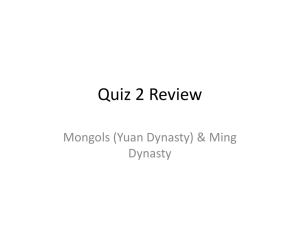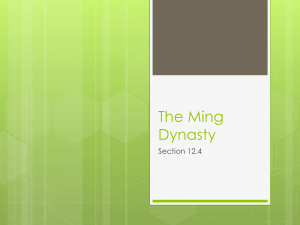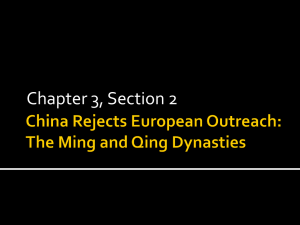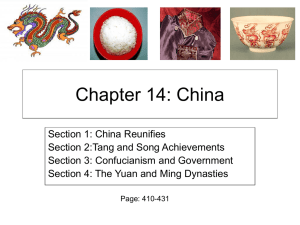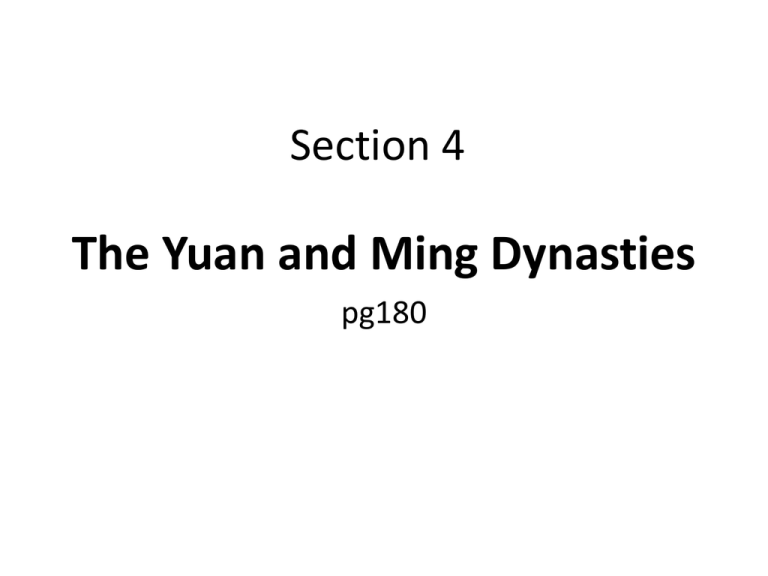
Section 4
The Yuan and Ming Dynasties
pg180
Key Terms and People
Genghis Khan -Ruler of the Mongols, he led his people in
attacks against China and against other parts of Asia. His
name means "universal leader."
Kublai Khan -Mongol ruler, he completed the conquest of
China and founded the Yuan dynasty.
Zheng He -Chinese admiral during the Ming Dynasty, he led
great voyages that spread China’s fame throughout Asia.
Isolationism -a policy of avoiding contact with other countries
The Chinese were ruled by foreigners
during the Yuan dynasty, but they threw off
Mongol rule and prospered during the
Ming dynasty.
• 1. The Mongol Empire included China, and the Mongols
ruled China as the Yuan dynasty.
• 2. The Ming dynasty was a time of stability and prosperity.
• 3. China under the Ming saw great changes in its
government and relations with other countries.
If YOU were there...
• You are a farmer in northern China in 1212. As
you pull weeds from a wheat field, you hear a
sound like thunder. Looking toward the sound,
you see hundreds—no, thousands—of armed
horsemen on the horizon, riding straight
toward you. You are frozen with fear. Only one
thought fills your mind—the dreaded Mongols
are coming.
• What can you do to save yourself?
BUILDING BACKGROUND
• Throughout its history, northern China had
been attacked over and over by nomadic
peoples. During the Song dynasty these
attacks became more frequent and
threatening.
The Mongol Empire
• Among the nomadic peoples who attacked the
Chinese were the Mongols. For centuries, the
Mongols had lived as separate tribes in the
vast plains north of China. Then in 1206, a
powerful leader, or khan, united them. His
name was Temüjin. When he became leader,
though, he was given a new title: “Universal
Ruler,” or Genghis Khan (JENG-guhs KAHN).
The Mongol Conquest
• Genghis Khan organized the Mongols into a
powerful army and led them on bloody
expeditions of conquest. The brutality of the
Mongol attacks terrorized people throughout
much of Asia and Eastern Europe. Genghis
Khan and his army killed all of the men,
women, and children in countless cities and
villages. Within 20 years, he ruled a large part
of Asia.
• Genghis Khan then turned his attention to
China. He first led his armies into northern
China in 1211. They fought their way south,
wrecking whole towns and ruining farmland.
By the time of Genghis Khan's death in 1227,
all of northern China was under Mongol
control.
1294
• The Mongol conquests did not end with Genghis
Khan's death, though. His sons and grandsons
continued to raid lands all over Asia and Eastern
Europe. The destruction the Mongols left behind
was terrible, as one Russian chronicler noted:
• “There used to be the city of Riazan in the land of
Riazan, but its wealth and glory ceased, and there
is nothing to be seen in the city excepting smoke,
ashes, and barren earth.”
• –from “The Tale of the Destruction of Riazan,” in
Medieval Russia's Epics, Chronicles, and Tales,
edited by Serge Zenkovsky
• In 1260 Genghis Khan's grandson Kublai
Khan (KOO-bluh KAHN) became ruler of
the Mongol Empire. He completed the
conquest of China and in 1279 declared
himself emperor of China. This began the
Yuan dynasty, a period that some people
also call the Mongol Ascendancy. For the
first time in its long history, foreigners
ruled all of China.
Life in Yuan China
• Kublai Khan and the Mongol rulers he led
belonged to a different ethnic group than the
Chinese did. They spoke a different language,
worshipped different gods, wore different
clothing, and had different customs. The
Chinese resented being ruled by these
foreigners, whom they saw as rude and
uncivilized.
• However, Kublai Khan did not force the
Chinese to accept Mongol ways of life. Some
Mongols even adopted aspects of the Chinese
culture, such as Confucianism. Still, the
Mongols made sure to keep control of the
Chinese. They prohibited Confucian scholars
from gaining too much power in the
government, for example. The Mongols also
placed heavy taxes on the Chinese.
• Much of the tax money the Mongols collected
went to pay for vast public-works projects.
These projects required the labor of many
Chinese people. The Yuan extended the Grand
Canal and built new roads and palaces.
Workers also improved the roads that were
part of China's postal system. In addition, the
Yuan emperors built a new capital, Dadu, near
modern Beijing.
• Mongol soldiers were sent throughout China
to keep the peace as well as to keep a close
watch on the Chinese. The soldiers' presence
kept overland trade routes safe for merchants.
Sea trade between China, India, and
Southeast Asia continued, too. The Mongol
emperors also welcomed foreign traders at
Chinese ports. Some of these traders received
special privileges.
• Part of what we know about life in the Yuan
dynasty comes from one such trader, an
Italian merchant named Marco Polo. Between
1271 and 1295 he traveled in and around
China. Polo was highly respected by the
Mongols and even served in Kublai Khan's
court. When Polo returned to Europe, he
wrote of his travels. Polo's descriptions of
China fascinated many Europeans. His book
sparked much European interest in China.
The End of the Yuan Dynasty
• Despite their vast empire, the Mongols were
not content with their lands. They decided to
invade Japan. A Mongol army sailed to Japan
in 1274 and 1281. The campaigns, however,
were disastrous. Violent storms and fierce
defenders destroyed most of the Mongol
force.
• The failed campaigns against Japan weakened the
Mongol military. The huge, expensive publicworks projects had already weakened the
economy. These weaknesses, combined with
Chinese resentment, made China ripe for
rebellion.
•
In the 1300s many Chinese groups rebelled
against the Yuan dynasty. In 1368 a former monk
named Zhu Yuanzhang (JOO yoo-ahn-JAHNG)
took charge of a rebel army. He led this army in a
final victory over the Mongols. China was once
again ruled by the Chinese.
ANALYZING VISUALS
How did Zheng He's crew
make sure they had fresh
food?
Path:
The
Ming
Dyna
sty
After
his
army
defea
ted
the
Mong
ols,
Zhu
Yuanz
hang
beca
me
empe
ror of
China
. The
Ming
dynas
ty
that
he
found
ed
ruled
China
from
1368
to
1644
—
nearl
y 300
years
.
Ming
China
prove
d to
be
one
of the
most
stabl
e and
prosp
erous
times
in
Chine
se
histor
y.
The
Ming
expan
ded
China
's
fame
overs
eas
and
spons
ored
incre
dible
buildi
ng
proje
cts
acros
s
China
.
Great
Sea
Voya
ges
Durin
g the
Ming
dynas
ty,
the
Chine
se
impro
ved
their
ships
and
their
sailin
g
skills.
The
great
est
sailor
of the
perio
d
was Z
heng
He (ju
hng
HUH).
Betw
een
1405
and
1433,
he
led
seven
grand
voya
ges
to
place
s
aroun
d
Asia.
Zhen
g
He's
fleets
were
huge.
One
includ
ed
more
than
60
ships
and
25,00
0
sailor
s.
Some
of the
ships
were
gigan
tic
too,
perha
ps
more
than
300
feet
long.
That
is
longe
r
than
a
footb
all
field!
In
the
cours
e of
his
voya
ges
Zhen
g He
sailed
his
fleet
throu
ghout
the
India
n
Ocea
n. He
sailed
as far
west
as
the
Persi
an
Gulf
and
the
easte
rnmo
st
coast
of
Africa
.
Copyright © by Holt, Rinehart
and Winston. All rights
reserved. Terms of
Use. Credits. Privacy
Policy.
The Ming Dynasty
• After his army defeated the Mongols, Zhu
Yuanzhang became emperor of China. The
Ming dynasty that he founded ruled China
from 1368 to 1644—nearly 300 years. Ming
China proved to be one of the most stable and
prosperous times in Chinese history. The Ming
expanded China's fame overseas and
sponsored incredible building projects across
China.
Great Sea Voyages
• During the Ming dynasty, the Chinese improved their
ships and their sailing skills. The greatest sailor of the
period was Zheng He (juhng HUH). Between 1405 and
1433, he led seven grand voyages to places around
Asia. Zheng He's fleets were huge. One included more
than 60 ships and 25,000 sailors. Some of the ships
were gigantic too, perhaps more than 300 feet long.
That is longer than a football field!
• In the course of his voyages Zheng He sailed his fleet
throughout the Indian Ocean. He sailed as far west as
the Persian Gulf and the easternmost coast of Africa.
• Everywhere his ships landed, Zheng He presented
leaders with beautiful gifts from China. He
boasted about his country and encouraged
foreign leaders to send gifts to China's emperor.
From one voyage, Zheng He returned to China
with representatives of some 30 nations, sent by
their leaders to honor the emperor. He also
brought goods and stories back to China.
•
Zheng He's voyages rank among the most
impressive in the history of seafaring. Although
they did not lead to the creation of new trade
routes or the exploration of new lands, they
served as a clear sign of China's power.
Great Building Projects
• The Ming were also known for their grand
building projects. Many of these projects were
designed to impress both the Chinese people
and their enemies to the north.
• In Beijing, for example, Ming emperors built
the Forbidden City. This amazing palace
complex included hundreds of imperial
residences, temples, and other government
buildings. Within the buildings were some
9,000 rooms. The name “Forbidden City”
came from the fact that the common people
were not even allowed to enter the complex.
For centuries, this city within a city was a
symbol of China's glory.
ANALYZING VISUALS
How did the Forbidden City show the
power and importance of the
emperor?
P
at
h:
• Ming rulers also directed the restoration of the
famous Great Wall of China. Large numbers of
soldiers and peasants worked to rebuild collapsed
portions of walls, connect existing walls, and
build new ones. The result was a construction
feat unmatched in history. The wall was more
than 2,000 miles long. It would reach from San
Diego to New York! The wall was about 25 feet
high and, at the top, 12 feet wide. Protected by
the wall—and the soldiers who stood guard along
it—the Chinese people felt safe from invasions by
the northern tribes.
China Under the Ming
• During the Ming dynasty, Chinese society
began to change. This change was largely due
to the efforts of the Ming emperors. Having
expelled the Mongols, the Ming emperors
worked to eliminate all foreign influences
from Chinese society. As a result, China's
government and relations with other
countries changed dramatically.
Government
• When the Ming took over China, they adopted
many government programs that had been
created by the Tang and the Song. However, the
Ming emperors were much more powerful than
the Tang and Song emperors had been. They
abolished the offices of some powerful officials
and took a larger role in running the government
themselves. These emperors fiercely protected
their power, and they punished anyone whom
they saw as challenging their authority.
• Despite their personal power, though, the Ming
did not disband the civil service system. Because
he personally oversaw the entire government,
the emperor needed officials to keep his affairs
organized.
•
The Ming also used examinations to appoint
censors. These officials were sent throughout
China to investigate the behavior of local leaders
and to judge the quality of schools and other
institutions. Censors had existed for many years
in China, but under the Ming their power and
influence grew.
Relations with Other Countries
• In the 1430s a new Ming emperor made Zheng He
return to China and dismantle his fleet. At the same
time, he banned foreign trade. China entered a
period of isolationism. Isolationism is a policy of
avoiding contact with other countries.
•
In the end, this isolationism had
great consequences for China. In 1644 the Ming
dynasty was overthrown. By the late 1800s the
Western world had made huge leaps in technological
progress. Westerners were then able to gain
influence in Chinese affairs. Partly due to its isolation
and lack of progress, China was too weak to stop
them.
SUMMARY AND PREVIEW
• Under the Yuan and Ming dynasties, Chinese
society changed. Eventually, the Ming began a
policy of isolationism. In the next chapter you
will read about Japan, another country that
was isolated at times.
Section 4 G.O.
History notebook pg 43
Identify key facts about China under the Yuan
and Ming dynasties.


